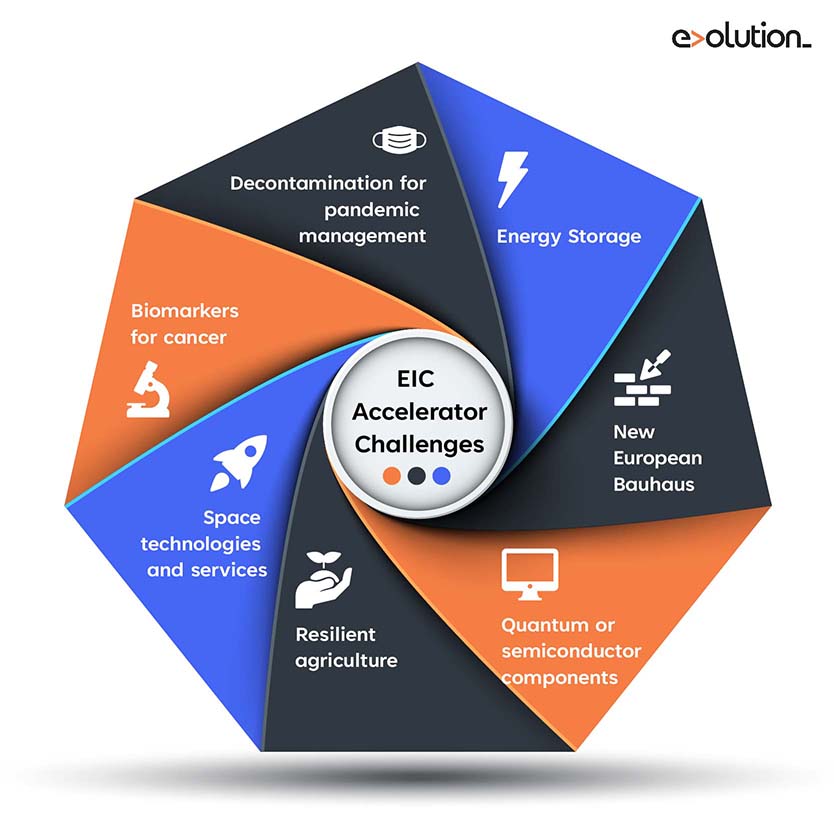What’s new in the EIC Accelerator programme in 2023, and why is this your year to apply?

EIC Accelerator is one of the European Commission’s flagship programmes to support deep-tech and high-impact innovative projects. Call after call represents a unique opportunity for start-ups and medium-sized enterprises (SMEs) aiming to transform the market or create new opportunities, but what’s new in 2023?
EIC Accelerator Open & Challenges: budget for this year
During 2023, the total indicative budget is €1.135.7 million, of which €612.98 million is allocated to Accelerator Open and €524.73 million to Accelerator Challenges.
EIC Accelerator provides blended finance to support your proposal:
- Investment component up to €15 million in the form of equity or quasi-equity (convertible loans). For market deployment and scale-ups, this option will bear the risks for high-risk innovations.
- Grant component up to €2.5 million for innovation activities completed within 24 months. It’s necessary to demonstrate your TRL and the nature of the technology to develop. You can request a Grant Only or Grant First support. This last one it’s great if you’re working on a novel technology (TRL 5-6) or based on research from the EIC Pathfinder, EIC Transition or European Research Council. Those companies are eligible for an equity component subject to a later milestone assessment.
The EIC jury may approve your project but, due to budget limits, doesn’t find financial support. In that case, it’s possible to be rewarded with a Seal of Excellence to help you obtain funding from alternative sources.
EIC Accelerator Open: is it for your start-up?
The short answer could be “yes”, as there are no predefined topics or sectors and proposals from any technology field are welcome.
Suppose your project is on TRL 5 or higher and represents a scientific discovery or a disruptive deep tech. In that case, EIC Accelerator Open will help you scale up in a shorter time by solving those issues related to funding risks during these innovation stages.
EIC Accelerator Challenges: what are the targeted goals for 2023?
EIC Accelerator Challenges always aim to solve existing problems through the most breakthrough technologies. The identified areas for this year are the following:
- Novel biomarker-based assays to guide personalised cancer treatment: To empower oncology treatments, EIC sets this challenge to improve its efficacy and safety, supporting technologies to optimise diagnostics and treatments.
- Aerosol and surface decontamination for pandemic management: The EIC seeks to create and commercialise technologies able to develop a resilient society under the threat of pandemics. Examples could be full systems for high-efficiency aerosol capture, next-generation face mask technologies or rapid surface decontamination devices.
- Energy Storage: In order to make progress in the field of sustainable energy, this challenge tries to find solutions for electrical and thermal energy storage. The indicative budget for this goal is higher than the others: €100 million.
- New European Bauhaus and Architecture, Engineering and Construction digitalisation for decarbonisation: A architecture transformation is necessary to achieve sustainable goals (like the ones set by the European Green Deal), as the way we build involves nearly half of the emissions. It’s a great chance to reimagine the built environment using computational design, digital fabrication or alternative materials.
- Emerging semiconductor or quantum technology components: The EIC wants to empower deep-tech start-ups developing cutting-edge quantum computing and quantum sensors to strengthen Europe’s technological autonomy. And also, it tries to contribute to the design and manufacture of advanced semiconductor chips able to be integrated into different devices and systems. This challenge could be a potential opportunity for sectors such as automotive, information and communication, healthcare, aerospace, security or energy, among others.
- Novel technologies for resilient agriculture: With this challenge, the EIC tries to alleviate the food supply situation affected by the COVID pandemic and the war in Ukraine, as well as prevent effects derivated from climate change. Projects related to regenerative agriculture, soil health and technologies to increase crops are some examples that can be included here.
- Customer-driven, innovative space technologies and services: This goal plans to develop an autonomous European Space infrastructure using, for instance, AI, Machine Learning or even technologies for in-orbit services and re-use old spacecraft.

What are the cut-off dates for 2023?
It’s possible to submit short applications continuously during 2023. However, full applications do have specific deadlines:
- 11th January 2023 (EIC Accelerator Open).
- 22nd March 2023 (EIC Accelerator Open and Challenges).
- 7th June 2023 (EIC Accelerator Open and Challenges).
- 4th October 2023 (EIC Accelerator Open and Challenges).
How do I know if my deep-tech project is eligible for EIC Accelerator?
Here we have a top tip: it is clever to ask for help. When facing a high-competitive programme such as EIC Accelerator is better to know all your possibilities to get funded before starting your short application.
That’s why it is positive to consider if you’d need external help to submit your deep-tech project to a programme like this (here are some 4 questions you can ask yourself first!).
At Evolution, we have more than 15 years of experience boosting innovative start-ups to achieve their funding goals. Do you want to be next?
Our team will be happy to guide you through the EIC Accelerator application process.
